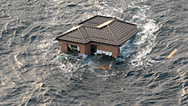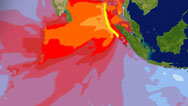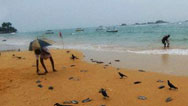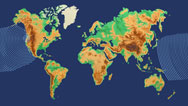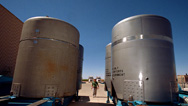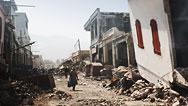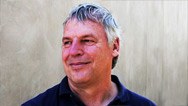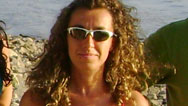
Japan's Killer Quake
An eyewitness account and investigation of the epic earthquake, tsunami, and nuclear crisis Airing February 27, 2013 at 9 pm on PBS Aired February 27, 2013 on PBS
- Originally aired 03.30.11
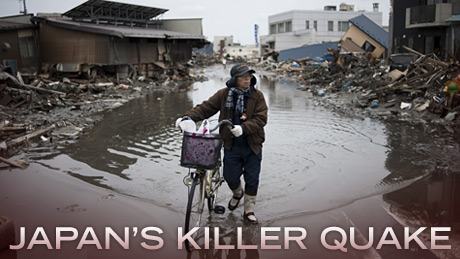
Program Description
Transcript
Japan's Killer Quake
PBS Airdate: March 30, 2011
NARRATOR: It is one of greatest tragedies of modern times: a quake so powerful it knocks the Earth off its axis; a tsunami leaves tens of thousands feared dead; parts of Japan shift 10 feet out to sea; parts of the coast drop over three feet. What forces create this epic disaster?
Now, a team of scientists is looking for answers.
ROGER BILHAM (University of Colorado): Never before have we had such a surplus of data. There are no mysteries in this earthquake; we know exactly what happened.
NARRATOR: Japan's coast lies in ruins. Incredibly, it could have been worse. Scientists' understanding of earthquakes and tsunamis saved lives, but as this disaster shows, there is much more to learn.
Japan's Killer Quake, right now on NOVA.
It is 96 hours since Japan's largest earthquake in a thousand years strikes. Professor Roger Bilham, from the University of Colorado, is one of the first geologists to survey the aftermath.
ROGER BILHAM: So, we're flying over the coast now, and much of the coast has sunk a meter. The extent of the damage is truly amazing. The tsunami picked up everything in its path—cars, houses, warehouses—and just tumbled them relentlessly inland, on and on and on.
One of the things I'd like to see is what kind of damage, what kind of debris gets left behind by these gigantic tsunamis.
NARRATOR: Every detail of the disaster is recorded by seismometers, strain gauges and tidal gauges. Now, Bilham looks to piece it all together, to find out exactly what happened and why so many lives have changed forever.
WOMAN (Tsunami Survivor/Translated): I wanted to find out, desperately, so I came here.
NARRATOR: How did this happen?
March 11, 2011; 2:46 p.m., Japanese time: Sixty miles off the northeast coast, a massive earthquake. Seismic waves race towards shore. The fastest waves, called P waves, travel at four miles a second. Fifteen seconds later they hit land. Japan's detection systems instantly pick them up. Within seconds, automatic warnings flash across the country. A computer-generated announcement interrupts a Japanese Parliament broadcast.
The coastal city of Sendai lies just 80 miles from the epicenter. There's almost no warning before slower, more destructive seismic waves, called S waves, hit the town. These slower S waves violently shake the ground from side to side. These are the waves that make earthquakes so damaging.
Already, northeast Japan is descending into chaos. The seismic waves travel on.
Ninety-three miles southwest of the epicenter, they slam into Fukushima Dai-ichi, home to an ageing nuclear power station, housing six reactors. This video, from a hospital near the reactor, reveals the earthquake's power.
Sensors at the plant automatically shut down the reactor cores. The reactors are in lockdown when the S waves hit, but the intense heat generated from the nuclear reaction process does not simply dissipate.
JIM WALSH (Massachusetts Institute of Technology): When you think shutdown, you think, uh, you know, the danger is gone, because it's shut down. But you know, if you have a pan in the oven, you shut the oven off, and the pan has been in there for an hour, and you go and grab it with your hands, you are going to get burned, because the oven continues to heat inside, even after you have turned it off.
NARRATOR: With the reactors stopped, there's no power to drive the cooling pumps. Emergency diesel generators take over, pumping coolant through the reactor. The Fukushima plant survives the earthquake intact.
Scientists 3,800 miles away at the Pacific Tsunami Warning Center, in Hawaii, receive emergency alerts. Researchers around the world see the event unfold.
GERARD FRYER (Pacific Tsunami Warning Center): Japan has lots of seismometers, so there was a lot of information, fast. So, the quake was still going on when we got our page.
NARRATOR: First indications: A magnitude of around seven, but, as data floods in, the numbers start to climb: 7.5, 7.7, up into the eights.
GERARD FRYER: The immediate reaction of everybody was, "That's not right," because in the history of Japan there has never been an earthquake larger than 8.4.
CHARLES MCCREERY (Pacific Tsunami Warning Center): It really tightened the intensity of what we were doing. We were dealing with something very big and something that could affect the whole Pacific basement.
GERARD FRYER: We realized, "Oh, this is it!" And then immediately you realize, "This is horrible for Japan."
NARRATOR: The source of this disaster lies 62 miles off Japan's coast. Four miles below the surface, the Earth is distorting, caught in a vast, slow-motion collision.
The Earth's crust is made up of several continent-sized slabs of rock: tectonic plates. Japan lies at the point where the Pacific plate rams into the Eurasian plate at three inches a year, about the same speed your fingernails grow. Japan is on the Eurasian plate. It compresses and buckles as the Pacific plate drives underneath it, snagging and catching as it goes. Over centuries, immense stress builds up, until suddenly the plates snap, causing an earthquake.
ROGER BILHAM: The energy that drove this earthquake had been building up for a couple of hundred years, caused by the movement of the Pacific plate towards the Eurasian plate. Think of it as a giant elastic band that's being wound up for 200 years.
NARRATOR: One hundred seconds since the fault line slipped: The destructive S waves reach Tokyo. The city has 60 seconds' warning. The quake lasts an unprecedented five minutes.
An American geologist is in Tokyo.
CHRIS GOLDFINGER (Oregon State University): We expected it to end after 10, 15, 20 seconds, something like that, maybe a minute, at the most. About minute three or four we were just astonished that it would just kept going and going.
We were just looking at each other going, "Is this over yet? No, it's not; it's still going."
TOM JORDAN (Southern California Earthquake Center): What is different about a big earthquake is that it begins but it doesn't stop.
CHRIS GOLDFINGER: It was kind of a growing realization that it was just getting bigger and bigger and bigger, and it had to be fairly close.
NARRATOR: An American tourist captures the ground opening up at his feet. The footage reveals a frequent characteristic of earthquakes: liquefaction.
MAN (American Tourist): Okay, we have an earthquake right now, and this is actually moving. You can see the cracks moving. That crack was not there. The crack is getting bigger and smaller, moving backwards and forwards, and there is water coming up in the park over there.
NARRATOR: Loosely packed and waterlogged ground near the surface starts to behave like a liquid. As the ground compresses, liquefied dirt pumps to the surface.
Most buildings still stand; Japan's earthquake warning systems work. Scientists upgrade this quake to a magnitude 9, a thousand times more powerful than the devastating 2010 Haiti quake. But everyone in Japan knows this is far from over. The earthquake's explosive energy is about to unleash another destructive force.
For centuries, the Eurasian plate is dragged downward by the Pacific plate grinding under it.
CHRIS GOLDFINGER: The whole upper plate behaves just like a rubber block. It just stresses like a spring, and when the earthquake happens, it springs back.
NARRATOR: The upward motion thrusts a four-mile-deep mass of water upward. When the dome collapses back, immense waves race out across the ocean, just three feet high and over 60 miles from front to back. A tsunami is born.
ROGER BILHAM: The energy heaves up the seafloor and displaces a huge volume of water that we can see made its way on land and made its way around the Pacific.
NARRATOR: One side of the wave takes off across the Pacific, the other races towards the coast of Japan.
COSTAS SYNOLAKIS (University of Southern California): Tsunamis travel very fast, at a speed that depends on the water depth. If it goes in the deep ocean, tsunami travels very fast, reaching, at times, the speed of a jet aircraft.
NARRATOR: Travelling at over 500 miles per hour, the wave takes just minutes to reach the coast. Here, the shallower seafloor slows down the front of the wave. The wave's fast-moving rear races in; it soon catches up with the front. The increasing pressure pushes the seawater up into a rising swell.
Three miles from shore, a Japanese coastguard crew witnesses the growing wave. The tsunami swells up, as the seafloor gets shallower. Once they crest the first wave, a second one is upon them. The crew is lucky to survive.
Near the coast, the swell becomes a breaking wave. It piles up. A wall of water races toward shore.
ROGER BILHAM: The very first thing that seems to have happened is that the sea left the land. And some of the footage we've seen shows the huge shoreline being exposed and then the tsunami built up offshore, and the dynamics of the wave carried it inland. Probably a cubic kilometer of water just squashed washed landward and kept going until it ran out of steam.
NARRATOR: This is the moment the first wave roars in. The tsunami has arrived, but there appears to be no clear pattern to when or where the tsunami strikes. First the north, then in the south, then it strikes in the north again. The height and intensity of the wave varies dramatically from town to town, but why?
Part of the answer lies in the varying depths of the seabed. The tsunami travels faster in deep water and reaches land more quickly. Another critical factor is the layout of the land. Cliffs, bays and inlets along the shoreline help determine how a tsunami behaves.
SIMON BOXALL (National Oceanography Centre, Southampton, England): It boils down to how the wave is focused and defocused by the geography, or the topography, of the coastline itself.
NARRATOR: 3:15 p.m., Japan time: The wave hits the town of Ofunato. Deep water off the coast here offers little resistance to the 26-foot-high tsunami wave. There is little time to get to high ground.
SIMON BOXALL: The best early warning system people would have had is the fact that there was an earthquake. People have gotten used to the fact that if you have an earthquake, there is a possibility that a tsunami might follow. But in the time they had, there was very little time or opportunity for escape.
NARRATOR: The tsunami hits Ofunato 20 minutes after the earthquake.
SIMON BOXALL: The water that hits the coast will be well in excess of a billion, probably 10 billion tons of water. That's a little bit like taking a million swimming pools and emptying them on the coastal areas of northeast Japan.
NARRATOR: Fifteen minutes later, the tsunami hits Sendai, 70 miles south of Ofunato. The area around the city is mostly farmland, low-lying and flat. The airport here is overwhelmed within minutes.
SIMON BOXALL: It hits very low-lying areas. There's nothing to stop it moving inland, and so it can move inland six, seven kilometers without being impeded.
CHRIS GOLDFINGER: If there's not much to slow it down...and because the wavelength of the tsunami is so big, it's not going to stop unless, until it reaches something, reaches some sort of high ground. And it will just keep on coming.
NARRATOR: Next, the wave slams the Miyako coast, 110 miles north of Sendai. This area has good tsunami defenses. The residents are well prepared; they should be safe. Last time a tsunami hit here was half a century ago. In the aftermath of that tsunami, they built these 30-foot-high seawalls. Tsunami drills are a regular feature of life. Everyone knows what to do when the sirens sound.
On March 11th, the sirens sound, this time, for real. The tsunami is minutes away.
MAN (Miyako Coast Resident): You hear the sirens.
MAN (Miyako Coast Resident): There's a hill outside of town that we're going to try and get to.
NARRATOR: Confusion rules. Some search for high ground. Some aren't sure what to do.
MAN (Miyako Coast Resident): It's a precautionary measure, but you never know. This town has a lot of history with tsunamis and a lot of death, so, you know they're taking it pretty seriously.
NARRATOR: The warning saves the lives of some.
MAN (Miyako Coast Resident): Here it comes!
NARRATOR: The tsunami easily breaches the coastal defenses. Miyako's high walls are useless. The tsunami is 30 feet high, so why did the 30-foot-high walls fail?
Data from thousands of sensors along the coastline suggest a stunning answer.
ROGER BILHAM: The fact that the shoreline has actually subsided means that the sea had plenty of space to go, and it, basically, filled up the empty space left by the sinking. Several villages have just been completely ruined with no survivors, and the human death toll is obviously going to be up in the tens of thousands when the final count is in.
NARRATOR: The earthquake causes the whole coastline to drop by up to three feet, lowering Miyako's walls and making the tsunami much worse. All along the coast this sudden drop in the height of the land puts towns in danger.
CHRIS GOLDFINGER: You have a tsunami wave coming in on top of what would be a two-meter-higher vacuum of subsided land, and there is not much to stop it until it hits higher ground somewhere.
NARRATOR: Fukushima's shutdown nuclear power plant is exposed. There is an 18-foot-high defense wall, but the ground has sunk several feet.
The wave smashes over the wall and floods the diesel generators cooling the reactor cores.
JIM WALSH: Japan, as part of its normal defenses against tsunamis, has, along its shore, a wall. The wave just blew right past it.
ROGER BILHAM: The coastline goes down, so do all their power intakes, and if they have a gigantic wave coming at them, it's going to short out everything electrical.
NARRATOR: Backup batteries take over to keep the pumps going, batteries with just an eight-hour charge.
The tsunami's destructive march inland overwhelms seawalls, erases whole towns and sets Japan on the path to a nuclear crisis. And it isn't over yet. Now, all that water pulls back out to sea.
SIMON BOXALL: ...huge suction as the wave retreats and drags the debris it's created on the way in—the cars, the lorries, the buses, the buildings, the people—and so they are sucked back out to sea.
NARRATOR: For miles offshore, the ocean is a churning mass of currents. Huge whirlpools form. Boats like this are no match for its power.
SIMON BOXALL: Sadly, I think many thousands of people will have been dragged out to sea, and I suspect, tragically, we're going to find bodies washing up along the coast of Japan for some months to come.
NARRATOR: During the night, fires rage across the wasteland. Oil from factories and natural gas from ruptured lines, set hundreds of square miles of debris on fire. In Tokyo, the train system is paralyzed. Millions sleep in offices and wait for dawn.
Eight hours since the quake: The tsunami wave continues to spread across the ocean. Countries all around the Pacific Rim watch nervously. In Hawaii, the Tsunami Warning Center is on full alert.
GERARD FRYER: Very quickly we realized that this was basically the first big ocean-crossing tsunami that had happened in 40 years.
NARRATOR: Will the tsunami hit Hawaii? If so, when? And how big will it be? Readings from deep ocean sensors suggest the wave is up to three feet high.
GERARD FRYER: Now that is monstrous. It was monstrous. At that point, we went to a Pacific-wide warning: phone calls everywhere.
NARRATOR: Hawaii issues an evacuation alert. People head for higher ground. The wave hits. As predicted, it's three feet high. For more than an hour, it surges over the islands.
Man (Hawaii Resident): Whoa! Gosh that is big, that is absolutely massive. Just lost my shoes. This is coming straight over the wall onto the main road. That is absolutely unbelievable. Here it comes again, pouring over the wall. You can see a car making a run for it out there. I'm completely stranded now, between the wall and the road.
NARRATOR: There is tens of millions of dollars in damage. The wave pulls houses out to sea. Hawaii's early warning system gives people time to get away from the coast. Here, unlike Japan, no one loses their life.
SIMON BOXALL: So the warning system works incredibly well, but, obviously, if the event happens, literally, on your back doorstep, no warning system that could ever be conceived would be quick enough.
NARRATOR: Tsunamis are simply unstoppable. But they can be tracked. The Hawaii warning team monitored the Japan tsunami across the pacific.
GERARD FRYER: We couldn't let our guard down, because, of course, the tsunami has carried on to the rest of the Pacific.
NARRATOR: The scientists effectively warned the world.
GERARD FRYER: As the tsunami spread across the ocean, at location after location, our predictions were pretty darn good.
NARRATOR: Japan's tsunami surges toward the U.S., its power diminishing with every passing mile.
SIMON BOXALL: It's a very intensive wave, but, obviously, as it spreads out, that energy is being distributed along a bigger and bigger circumference.
NARRATOR: Ten hours later, and over 5,000 miles from the quake, the tsunami, now smaller and weaker, finally hit California. The wave still created havoc along the coast.
SIMON BOXALL: There, certain parts of the coast focused the wave, so, although it was only one meter in Hawaii, it actually became two meters in places like Crescent City, in California, and, again, because people were warned, there was very little destruction or damage or loss of human life. One person did lose their life, north of Crescent Bay, because they rushed down to the beach to take photos of the tsunami as it came in.
NARRATOR: Back in Japan, the crisis continues to escalate. Different locations suffer different effects. Veteran journalist Callum Macrae sets off along the coast to discover how far reaching the tsunami's damage is.
This is the isolated mountain community of Kahoku.
CALLUM MACRAE (Journalist and Filmmaker): We are up in the mountains, eight kilometers from the coast, and what's happened here is that the tsunami has created a huge surge, which has climbed all the way up the river and then flooded here.
NARRATOR: The result is stunning: a new saltwater lake among mountains, miles from the sea.
MAN (Kahoku Resident/Translated) Normally, there is just a little river at the back here. Usually, there is very little water in it.
The first wave of the tsunami didn't affect us, but from the second wave, water started to reach here. By the next morning this was all flooded.
The water has stayed here ever since.
I am 70 years old, and I have never seen anything like this.
NARRATOR: The locals here fear the receding waters will expose bodies swept up from the coast.
Travelling north, at first, the town of Ofunato seems untouched.
CALLUM MACRAE: Look over there. Those houses in this part of town look undamaged. They've got power and everything here. It's just so strange. It looks like a normal bustling town.
NARRATOR: Closer to shore, it is a different story.
CALLUM MACRAE: As if Ofunato didn't have enough problems, scientists reckon this whole area, this region, has subsided well over one meter. And in the next couple of days the region is also expecting the highest tides of the year.
The sea is some 500 meters down there, and yet, up here, we have an extraordinary sight, by any standards. It's a huge tug that has been brought all the way up here by the tsunami. What's even more remarkable is what is says about the size of the tsunami, because the Japan meteorological center just sent out a provisional estimate that the tsunami that hit this was somewhere about three meters high, but we are standing seven or eight meters above sea level here, and even with the surge, the idea it could have carried this boat here, does suggests that the tsunami was much bigger than three meters.
NARRATOR: Boats, trucks and cars were dumped on top of buildings, much higher than the recorded height of the wave.
SIMON BOXALL: That happens because, as the water is pushing through the restricted areas, like the streets and towns, it is being effectively funneled. The water has to go somewhere, so it goes up, because it is squeezed and funnelled and pushes material—cars—onto roofs, sometimes as high as 50 feet. So, in areas, the impact of this will be even greater, particularly where you get narrow streets.
CHRIS GOLDFINGER: Once the wave starts to pick up part of town, the warehouses along the dock, the debris, then it becomes more like a glacier. It is a moving wall of debris. The more mass it has, the more power it has. It doesn't look like water, it looks like the entire town is flowing, and it is. And all the mass of the building, fridges, everything in that wall is essentially a debris glacier. And it just keeps coming in.
NARRATOR: This is Minami Sanriku, a town that has been virtually wiped off the map: ninety five percent of the buildings destroyed, over 10,000 people—half the population—missing.
This place symbolizes the tragedy more than anywhere - an entire town wiped out by the force of nature.
SIMON BOXALL: It's almost difficult to imagine one's thoughts, as you see it coming towards you and as it hits the coast. It's then picking up all the debris, it's picking up cars and things. You end up with this horrific mass moving through towns and villages causing complete destruction.
CHRIS GOLDFINGER: It would be bad enough it if it was just water, but, because it's full of cars, you can't swim against it, or swim with it, or do anything. You are just in front of a bulldozer, moving the entire town.
CALLUM MACRAE: It's funny, when you hear that sound of an ambulance, it gives you hope that they have found someone alive, although that must be happening fewer and fewer times between. Anyone who did survive and who was trapped would have almost certainly have died of hypothermia, by now.
NARRATOR: At the town of Rikuzentakata, 25 miles up the coast, rescue workers hunt for survivors and discover the dead.
CALLUM MACRAE: When they find a body, they put a large stick with a flag attached to it, so that it can be recovered later. It's a fairly gruesome and sad task. In fact, they are not just looking for bodies, they are also collecting personal mementos, as well, which they find, like this.
I'm afraid what we have here is more bodies waiting to be taken away.
NARRATOR: Within days, scientists gather more data from Japan's earthquake and tsunami than from any other disaster in history.
Over Tokyo, Professor Roger Bilham returns from his aerial survey. The city's vulnerability is clear.
ROGER BILHAM: There are 30-million people within about two meters of sea level, and a tsunami here would be absolutely devastating.
NARRATOR: Suddenly, there is a problem.
WOMAN (Controller): We had a big earthquake just now.
ROGER BILHAM: We've just learnt, from the ground, that there was an earthquake that damaged the heliport. They are just checking, right now. We don't know how big that earthquake was, but it was obviously a very nearby aftershock.
NARRATOR: A massive aftershock hits Tokyo: magnitude 6.2.
In the week that follows the main quake, there are over 500 aftershocks. This is the actual data from seismometers around Japan: the larger the circle, the bigger the aftershock.
WOMAN (Controller): Just checking now to radio sound.
NARRATOR: Finally, Bilham's helicopter receives the all-clear to land. The helipad is damaged.
ROGER BILHAM: I notice that the tarmac here, which should be beautifully dark everywhere, is, in fact, stained white. In fact, sand has come out of this crack, and there's another one over there, another one over there. We are very close to the shoreline, and the lurching motion of the ground, during the earthquake has caused the sub-surface liquefied sands to come belching out on the top.
NARRATOR: Here, there is evidence of liquefaction, the strange phenomenon filmed earlier.
ROGER BILHAM: Over here is an old mud volcano. It's about three-days old. You can see how the mud came pouring out over the top. We are 200 miles from the epicenter here, and here's a crack in the heliport landing area. It continues over the heliport. It continues all along here, and you can see three feet down. In places, it splits into two. You can see an offset in the trim around the tarmac.
NARRATOR: As the Earth's crust shatters during the main quake, new stresses spread along the fault. Relieve the pressure in one place, and it builds up somewhere else, triggering aftershocks.
TOM JORDAN: What you are seeing here is how those aftershocks happened after the main shock; gives an idea of the area of the fault that ruptured.
NARRATOR: Every aftershock takes its toll on an already frightened population. And every aftershock potentially triggers another one.
ROGER BILHAM: The main shock, that was followed by hundreds of magnitude 5s and dozens of magnitude 6s, handful of magnitude 7s. Once you have a pattern of a quake followed by a bigger one, you never know if it will happen again.
NARRATOR: Unrelenting tremors are just one of the new realities facing the Japanese people. Hundreds of thousands are homeless. In the regional capital of Sendai, the temporary shelters are full. But in this darkened, ravaged city, people do their best.
CALLUM MACRAE: We're in Sendai, 3- or 400 meters from the shorefront, in a scene of apocalyptic chaos. It's cold, it's dark, there's no power anywhere, and yet up there, in that abandoned block of flats, on the top floor, there is one light, one man, one family, perhaps, trying to survive in the chaos.
NARRATOR: The following day, on the main road back to Tokyo: The artery that connects north and south is empty, a reminder that this country has ground to a halt.
MAN'S VOICE (Broadcaster/Translated): This is already one of the worst nuclear accidents in history if it stops right now, and we're dealing with multiple meltdown possibilities.
WOMAN'S VOICE (Broadcaster/Translated): Two radioactive substances, cesium and iodine, were detected near the number one reactor on Saturday.
CALLUM MACRAE: The Fukushima nuclear base is about 60 kilometers that way; that's about 38 miles that way. Got windows closed, driving very fast; who knows if it's safe? The advice is very conflicting. The American government imposed 80-mile exclusion zones, and, of course, we're well within that. The Japanese government say 30 kilometers, so who can tell? We'll keep the windows closed, and I'll put on a mask.
NARRATOR: At Fukushima power plant, the nuclear crisis worsens. The emergency batteries are dead. There is no power to cool the reactors. Temperatures quickly rise; water levels drop; pressure builds. The incredible heat of the fuel rods generates hydrogen gas. The hydrogen explodes.
Desperate plant workers inject seawater into the reactors in an effort to cool them.
JIM WALSH: Essentially, those plant operators said, "We are going to commit plant suicide. We're going to kill these plants," knowing that they will never work again, but knowing that this was a better option than letting the cooling systems fail and having a worse outcome.
WOMAN's VOICE (Broadcaster): There's been another blast at the stricken nuclear power plant, the second hydrogen explosion in three days.
NARRATOR: The Japanese military use helicopters to scoop up seawater to dump on the reactors. It doesn't work. The long-term consequence of what is happening at Fukushima remains unknown.
The humanitarian disaster continues. Estimates put the death toll from the quake and tsunami at over 20,000. For scientists, the analysis goes on. From all the data they have acquired, one threat is still very real.
For years, experts have warned of a large quake and tsunami off the coast, near Tokyo. Japan's recent disaster happens 260 miles north. But now the fault lines below Tokyo are even more stressed.
ROGER BILHAM: What's been expected is a slip of the Philippine plate, relative to the Eurasian plate, but what has occurred is a slip of the Pacific plate relative to the Eurasian Plate. Sometimes a great earthquake will cause the next patch of the plate boundary to slip, so all eyes are on the...what's happening, how this earthquake has stressed the neighboring part of the plate boundary. You've got to understand that this whole region is in a very high state of stress and is ready to go. And they've been expected to go at any minute, so the question is how much closer
TOM GOLDFINGER: When an earthquake like this happens, all of the stress in the Earth's crust gets transferred somewhere else. It doesn't just go away. It adds loading to other parts of the crust.
NARRATOR: The densest areas of population survive largely unscathed. Next time could be different.
TOM JORDAN: One area of extreme concern is Tokyo, the world's largest city. There could be a major event in Tokyo, which could be very damaging to this very densely populated region.
BILL MCGUIRE (University College London): If you were to choose somewhere to put one of the major industrial economies on the planet. That part of the Pacific you would not choose.
ROGER BILHAM: It could be happening as we speak, or it might not happen for a decade.
BILL MCGUIRE: The thing is, has this particular earthquake shaken that region up, so it brings forward the timing of that earthquake?
COSTAS SYNOLAKIS: It's foolish to think that we can stop a natural disaster. What we have got to do is live with them and minimize the consequences when they happen and minimize, also, the recovery time.
SIMON BOXALL: It's very difficult for science to protect against earthquakes and tsunamis. What science can do is help tell planners, engineers to make buildings stronger, To make designs of buildings and cities resilient. We cannot stop these things happening. We can't prevent it; we can prepare for it.
NARRATOR: Scientists believe Japan's tsunami holds valuable lessons for the U.S.
ROGER BILHAM: What is interesting about this earthquake is that it's a template for what may occur on the northern coast of Oregon and Washington. We know, there, we are expecting an almost identical-sized earthquake.
NARRATOR: Stretching from Vancouver Island to Northern California is Cascadia, a vast and volatile fault line. Here, like Japan, one plate is driving beneath another, squeezing and compressing it. Tremendous pressure builds.
Cascadia could rupture in a huge magnitude 9 quake. A mega-quake off the Pacific Northwest coast would create a tsunami similar to Japan's. Roger Bilham scans the coast of Japan for clues. He hopes to understand what could happen to America's west coast.
ROGER BILHAM: Like this coastline is long and flat—parts of the Oregon coast are mountainous, it's not going to be a problem—but where we have flat-lying land we've got to expect a similar effect.
CHRIS GOLDFINGER: It's a little bit like airplane crashes that people go in and try to figure out what happened and to learn form that. Unfortunately, we learn from these disasters, but it makes people stronger for the next one.
NARRATOR: The world has seen what happened in Japan. The question is, "Are we prepared?"
CHRIS GOLDFINGER: When we compare it to Japan, where the preparation is higher than what we have in the U.S., and we see that the Japanese had still quite a ways yet to go, it's a little sobering. And you think about how many decades of work we have in front of us, just to get to where the Japanese were. And then we have to get beyond that as well.
Broadcast Credits
Japan's Killer Quake
- Edit Producers
- Rae Gilder
Tom Pearson - Location Directors
- Stephanie Kern
Brian Leckey
Simon Ludgate
Callum Macrae - Written and Produced By
- Richard Burke-Ward
Robert Strange - Edited By
- Sarah Hewer
Andy Flynn
Rob Sylvester - Camera
- Joe Baram
Carl Davis
Boyd Estus
Paul Lang
Brian Leckey
Allan Palmer
Robin Probyn
Anna Rieke - Sound Recordists
- Frank Coakley
Tomo Kitani
David Lerner
Paul Miller
David Pickner
Dan Tokumaru - Location Producer
- Luisella Palladino
- Narrated By
- Corey Johnson
- Music
- Audio Networks
- Graphics
- Weave
- Line Producer
- Zoe Elliott
- Online Editor
- Steve Gilbert
- Audio Mix
- Joe Cochrane
- Researchers
- Lindsey Truman
Helen Wollner
Katie Brimblecombe - Archival Material
- AP Archive
Asia News Network
Ayumu Dokizono
BBC Motion Gallery/Thought Equity Motion
BNVN
Brent Kooi
CNN Image Source
Discovery Communications Inc
Geoeye Satellite Image
Framepool
Los Ojos De Ella
NASA World Wind
Netagu
Japan Broadcasting Corporation
NOAA
Nippon Television Network Corporation
Photolibrary/Oxford Scientific
Thought Equity - Special Thanks
- Brian Barnes – Save Japan Dolphins Campaign
Nick Bundle
Nikki Matsumato
Luisella Palladino - For Pioneer Productions
- Executive Producer
- Stuart Carter
- Head of Development
- Jeremy Dear
- Head of Production
- Kirstie Mclure
- Head of Finance
- Peter Dunkerley
- NOVA Series Graphics
- yU + Co.
- NOVA Theme Music
- Walter Werzowa
John Luker
Musikvergnuegen, Inc. - Additional NOVA Theme Music
- Ray Loring
Rob Morsberger - Post Production Online Editor
- Spencer Gentry
- Closed Captioning
- The Caption Center
- Publicity
- Eileen Campion
Victoria Louie
Karen Laverty - Marketing
- Steve Sears
- Researcher
- Kate Becker
- NOVA Administrator
- Kristen Sommerhalter
- Production Coordinator
- Linda Callahan
- Paralegal
- Sarah Erlandson
- Talent Relations
- Scott Kardel, Esq.
Janice Flood - Legal Counsel
- Susan Rosen
- Associate Producer Post Production
- Patrick Carey
- Post Production Supervisor
- Regina O'Toole
- Post Production Editor
- Rebecca Nieto
- Post Production Manager
- Nathan Gunner
- Compliance Manager
- Linzy Emery
- Development Producers
- Pamela Rosenstein
David Condon - Supervising Producer
- Stephen Sweigart
- Business and Production Manager
- Jonathan Loewald
- Senior Producer and Project Director, Margret & Hans Rey / Curious George Producer
- Lisa Mirowitz
- Coordinating Producer
- Laurie Cahalane
- Senior Science Editor
- Evan Hadingham
- Senior Series Producer
- Melanie Wallace
- Executive Producer
- Howard Swartz
- Managing Director
- Alan Ritsko
- Senior Executive Producer
- Paula S. Apsell
Produced by Pioneer Productions For NOVA In Association With Channel 4
© 2011 Pioneer Film and Television Productions Limited and WGBH Educational Foundation
All Rights Reserved
Image
- (person on bicycle)
- FRED DUFOUR/AFP/Getty Images
Participants
- Roger Bilham
- Geologist
- Simon Boxall
- National Oceanography Center, Southampton
- Gerard Fryer
- Pacific Tsunami Warning Center
- Chris Goldfinger
- Oregon State University
- Tom Jordan
- Director, SCEC
- Callum Macrae
- Journalist and Filmmaker
- Charles Mccreery
- Pacific Tsunami Warning Center
- Costas Synolakis
- Coastal Engineer, USC
- Jim Walsh
- Nuclear Security Expert, MIT
Preview
Full Program | 53:07
Full program available for streaming through
Watch Online
Full program available
Soon

